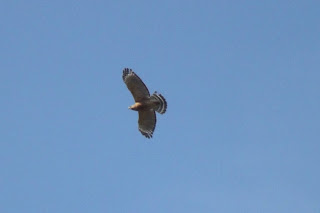It wouldn’t seem quite like autumn without the hawks and falcons hunting along fencerows, darting through the woods, or soaring on the breezes. I have been seeing a number of raptor species lately, including the swift and agile Cooper’s Hawks, the slower but more powerful Red-tailed Hawks, the wary and fidgety American Kestrels, and the high-soaring (at this time of year, as they migrate) Broad-winged Hawks. But the species that I see most frequently in my neck of the woods is actually none of these: it’s the Red-shouldered Hawk, a member of the genus Buteo and a close relative of the Red-tailed and Broad-winged Hawks. Red-tailed Hawks might be more common and widespread, but the types of habitats near my home are simply better for Red-shouldereds, and that’s fine with me.
Unlike Red-tailed Hawks, Red-shouldered Hawks tend to prefer low-lying, heavily wooded environments. They are commonly found year-round in many hardwood and mixed forests throughout southeastern North America, and, in the fall and winter, this southeastern population is boosted by migrants from the northeastern United States and southeastern Canada. The difference in habitat between Red-shouldered and Red-tailed Hawks means that their dietary preferences are a bit different, as well; like Red-tails, Red-shouldereds eat lots of small mammals, but, because they inhabit denser, swampier woods, they’re also likely to catch frogs, snakes, and lizards. However, even though they’re primarily forest hawks rather than field hawks, they will often hunt from powerlines and prominent snags at the borders of woodlands and fields. Presumably, this makes it easier for them to find and catch their prey, given that they lack the maneuverability of species such as the Cooper’s and Sharp-shinned Hawks.
Appearance-wise, Red-shouldered Hawks are a little smaller and slimmer than Red-tailed Hawks, and, of course, they lack the brick-red tails that adult Red-tails have. They DO have reddish-brown “shoulders,” but this usually isn’t the most obvious field mark. The barred, reddish-brown breasts, black-and-white banded tails, and black-and-white wings on the adult hawks are far more noticeable features in the field. As you can see in the first of the two photos below, there are also vertical breast streaks on top of the chestnut-colored horizontal barring. Juvenile Red-shouldered Hawks look fairly similar to the adults, but have drabber, browner feathers and lack reddish barring on their breasts. In flight, both adults and juveniles show “wing windows,” which are essentially just pale crescents near the wingtips. This is a great field mark to look for if a hawk is soaring overhead.
 |
| The rusty breast feathers on this adult hawk are a useful field mark. |
 |
| Juveniles have browner plumage and streaks on their breasts. |
 |
| Crescent-shaped wing markings are visible on this soaring adult hawk. |
Source:
Dykstra, C. R., J. L. Hays, and S. T. Crocoll (2020). Red-shouldered Hawk (Buteo lineatus), version 1.0. In Birds of the World (A. F. Poole, Editor). Cornell Lab of Ornithology, Ithaca, NY, USA. https://doi.org/10.2173/bow.reshaw.01
